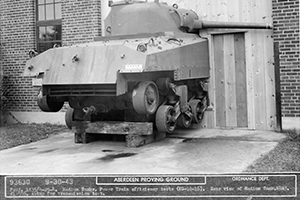100 Years of Excellence: The ATC Story, Part 4
Excerpted from an article by Lauren Nelson

During World War II every type of weapon, from a pistol to a 16-inch gun, and numerous variants of tank, tractorand jeep, were tested, fired and driven at APG. The hours were grueling as personnel labored on tests at all hours, day and night. Between 200 and 350 test projects usually occurred at once, and from five to a dozen directives for new projects were received weekly. There were two basic types of testing: experimental and acceptance. Experimental testing was applied to newly designed weapons to test all competencies. Acceptance testing was conducted on standard weapons to ensure they operated properly. Noteworthy results include the standardization of many rocket items, bazooka (the only completely original all-American weapon of WWII), M3 submachine gun, M8 armored car, M12 tank destroyer and M15 half track. Others include the recoilless rifle and VT fuze, also called a proximity fuze or “the fuze that thinks.” This fuze contained a small radio which could detonate a shell, bomb or rocket when it was in the perfect position to cause the most damage to its target. Each of these items certified that the military overseas had the best weapons technology possible in Europe, Africa and the Pacific.
During these days, APG’s Proof Department earned its colossal reputation. It had become known as a “get it done” organization. All of these accomplishments were recognized when the Post received the Army-Navy “E” award for excellence in achievement in the production of war equipment on September 28, 1942. APG was the first Army-operated plant to earn the award, and the ceremony was witnessed by over 30,000 military and civilian personnel who had made it possible.
The beginning of the end of WWII was announced with V-E, or Victory in Europe, Day on May 8, 1945. This triumph spurred the Ordnance Research and Development Center, as the proof center was called at the time, into a final push which ended on August 14, 1945, with V-J, or Victory in Japan, Day.
Activity at APG slowed significantly after the war was over, though personnel never lost their dedication to the mission. The force was reduced, and the number of projects taken on by the Ordnance Research and Development Center (ORDC) dwindled. Facing a new period of peace, the organization threw itself into the task of redefining its purpose and mission.
The ORDC reorganized in 1946 into three tenants: Development and Proof Services (D&PS), Ballistic Research Laboratory (BRL) and the Aberdeen Ordnance Depot. D&PS became the central hub of testing for the Army, carrying on the Proof Department’s mission. The BRL separately pursued scientific development and research. D&PS covered the testing of all types of materiel and combined the vehicular, weapons, munitions and fire control missions to ensure the offensive and defensive potentials of every item were thoroughly investigated.
In October 1946, a 100-ton T28 superheavy tank armed with a 105-mm gun was unveiled to the public, as well as a fully automated Garand rifle, a 75-mm recoilless rifle fired from the shoulder, and a 75-mm and 105-mm recoilless rifles fired from lightweight tripods. A mobile dynamometer, a 60-ton, 40-ft vehicle designed to analyze the power characteristics of Army tanks and other heavy vehicles, began testing in 1947. This new technology saved time and effort on the part of testers who previously had to gather that data manually.
The world’s first digital computer, developed at APG, was completed in 1947. The Electronic Numerical Integrator and Computer (ENIAC), weighed 30 tons, required 18,000 electronic tubes, had a 100-foot front panel, and was purportedly tended to by women in roller skates. In 1948, construction on the Supersonic Wind Tunnel (SWT) was completed; at the time, this was the largest SWT capable of producing an airstream that could exceed Mach 4, or four times the speed of sound.
to be continued on next issue
You are now leaving www.atc.army.mil and entering another site. You will automatically be forwarded to the target page within five seconds.
